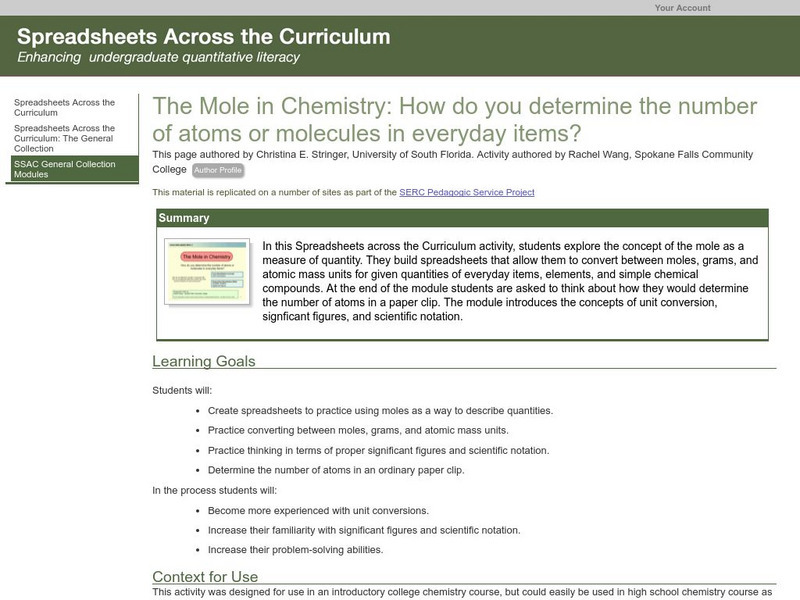Chem4kids
Chem4 Kids: Atoms: Neutrons
Students will find an explanation of the neutron particle located inside the atom's nucleus. Website also defines isotopes and the process of radioactive decay.
Thomas Jefferson National Accelerator Facility
Jefferson Lab: It's Elemental: Element Math Game
The interactive activity examines the Periodic Table of Elements. Learners answer questions about the number of protons, electrons, neutrons, or nucleons that an atom of an element contains.
Environmental Chemistry
Periodic Table of Elements: Gallium
A very detailed look at the element Gallium, a member of the Boron Group.
Other
University of Kansas: Quarked!: Matter Mechanic
Build elements and molecules using neutrons, protons, and electrons. Choices include helium, carbon, oxygen, aluminum, water, and salt.
Science Education Resource Center at Carleton College
Serc: The Mole in Chemistry: Determining the Number of Atoms in Everyday Items
Students explore the concept of the mole as a measure of quantity. They build spreadsheets that allow them to convert between moles, grams, and atomic mass units for given quantities of everyday items, elements, and simple chemical...
Ducksters
Ducksters: Chemistry for Kids: Elements: Boron
Study the element boron and its chemistry including atomic weight, atom, uses, sources, name, and discovery on this site. Plus properties and characteristics of this element.
Ducksters
Ducksters: Chemistry for Kids: Elements: Tin
On this site, kids learn about the element tin and its chemistry including atomic weight, atom, uses, sources, name, and discovery. Also find the properties and characteristics of tin.
Ducksters
Ducksters: Chemistry for Kids: Elements: Sodium
Kids learn about the element sodium and its chemistry including atomic weight, atom, uses, sources, name, and discovery. Plus properties and characteristics of sodium are discussed.
Ducksters
Ducksters: Chemistry for Kids: Elements: Sulfur
Explore the properties and characteristics of sulfur on this site. Kids can learn about the element sulfur and its chemistry including atomic weight, atom, uses, sources, name, and discovery.
Ducksters
Ducksters: Chemistry for Kids: Elements: Silicon
Investigate the properties and characteristics of silicon. Students can study the element silicon and its chemistry including atomic weight, atom, uses, sources, name, and discovery.
Ducksters
Ducksters: Chemistry for Kids: Elements: Potassium
Study the properties and characteristics of potassium on this site. Learn about the element potassium and its chemistry including atomic weight, atom, uses, sources, name, and discovery.
Ducksters
Ducksters: Chemistry for Kids: Elements: Platinum
Explore information about the element platinum and its chemistry including atomic weight, atom, uses, sources, name, and discovery. Also learn about the properties and characteristics of platinum on this site.
Ducksters
Ducksters: Chemistry for Kids: Elements: Nitrogen
Kids learn about the element nitrogen and its chemistry including atomic weight, atom, uses, sources, name, and discovery. Plus properties and characteristics of nitrogen.
Ducksters
Ducksters: Chemistry for Kids: Elements: Manganese
Research the element manganese on this site by finding its chemistry including atomic weight, atom, uses, sources, name, and discovery. Plus properties and characteristics of manganese.
Ducksters
Ducksters: Chemistry for Kids: Elements: Oxygen
Kids learn about the element oxygen and its chemistry including atomic weight, atom, uses, sources, name, and discovery. Plus properties and characteristics of oxygen.
Ducksters
Ducksters: Chemistry for Kids: Elements: Plutonium
Find information about element plutonium such as its properties and characteristics. Also study its chemistry including atomic weight, atom, uses, sources, name, and discovery.
Ducksters
Ducksters: Chemistry for Kids: Elements: Nickel
Kids learn about the element nickel and its chemistry including atomic weight, atom, uses, sources, name, and discovery. Plus properties and characteristics of nickel.
Ducksters
Ducksters: Chemistry for Kids: Elements: Magnesium
Kids learn about the element magnesium and its chemistry including atomic weight, atom, uses, sources, name, and discovery. Plus properties and characteristics of magnesium.
Ducksters
Ducksters: Chemistry for Kids: Elements: Argon
Kids learn about the element argon and its chemistry including atomic weight, atom, uses, sources, name, and discovery. Plus properties and characteristics.
Ducksters
Ducksters: Chemistry for Kids: Elements: Carbon
Kids learn about the element carbon and its chemistry including atomic weight, atom, uses, sources, name, and discovery on this site. Also, study the properties and characteristics of carbon.
Ducksters
Ducksters: Chemistry for Kids: Elements: Chromium
Kids learn about the element chromium and its chemistry including atomic weight, atom, uses, sources, name, and discovery on this site. Also discussed is the properties and characteristics of chromium.
Ducksters
Ducksters: Chemistry for Kids: Elements: Aluminum
Kids learn about the element aluminum and its chemistry including atomic weight, atom, uses, sources, name, and discovery. Plus properties and characteristics.
Ducksters
Ducksters: Chemistry for Kids: Elements: Beryllium
Explore the element beryllium on this site. Learn about its chemistry including atomic weight, atom, uses, sources, name, and discovery as well as its properties and characteristics.
Ducksters
Ducksters: Chemistry for Kids: Elements: Calcium
Kids learn about the element calcium and its chemistry including atomic weight, atom, uses, sources, name, and discovery. Plus properties and characteristics of calcium.
Other popular searches
- Science Elements, Atoms
- Elements and Atoms
- Atoms Elements Compounds
- Atoms Elements and Compounds
- Chemical Elements Atoms
- Candy Atoms and Elements
- Science Elements Atoms
- Science Elements and Atoms
- Physics Atoms and Elements
- Atoms Elements Review
- Chemistry Elements Atoms
- Elements Atoms























